Budget 2021 and its Implications for Migration
Budget 2021 was released on Tuesday night. Amongst some of the headline items are:
- Australia’s “economic engine is roaring back to life”, according to Treasurer Josh Frydenberg;
- economic growth is forecast to reach 4.2% in 2021-2022; and
- unemployment is forecast to be as low as 4.75% in 2022-2023.
This all appears to be good news indeed.
However, many of the media outlets have reported that migration will be a “loser” from the Budget. It is expected that international borders will not reopen until mid-2022. Net overseas migration is expected to be in the negative by 96,600 people in 2020-2021. It has not been in the negative since 1916.
There are clearly some challenges, both for intending migrants as well as for Australia’s skills pool. But there are also some opportunities.
Here are my thoughts:
- With the economy continuing to grow, there will be significant demand across many sectors for skilled workers. Anecdotal evidence from employers suggests that this demand will be difficult to meet. The budgetary measures to level-up the skilling of Australians will take time to bear fruit.
- For employers in critical sectors, there remains the ability to apply for exemptions to the border closures to enable skilled workers to enter Australia. This will need to be looked at on a case-by-case basis.
- Employers may consider tapping into a large pool of skilled international student graduates who are looking to remain in Australia in the long term.
- International borders will remain closed to overseas students, although there is some word of localised travel bubbles being negotiated. In Western Australia, we will likely be the last of the States to negotiate a travel bubble, given our historical conservatism in keeping our borders shut. This means that WA educational institutions will continue to bear the brunt of decreased international student numbers.
- Existing international students may consider visa options available to them to remain in Australia longer. This may include further studies to upskill them into an occupation which may support a more permanent visa outcome.
- Perth remains a privileged city despite its relative isolation and ongoing border closures. It is a “regional area” for migration purposes and supports applications for Subclass 494 Regional Employer Sponsored visas for a significant cohort of skilled workers. International students can also take advantage of Perth’s regional status to renew their Subclass 485 Graduate Visas for an extra 12 months (or an extra 24 months if they live and work outside the metropolitan area).
In recent times, we have also fielded a large number of enquiries for former permanent residents looking to return to Australia on Resident Return Visas. In the midst of the COVID pandemic, Australia’s stability and economic strength are attracting these former residents back. Prospects of recovering residency should be explored.
The Government’s new “bright line” tax residency rule, namely that individuals will be deemed Australian tax residents where they are physically present in Australia for a minimum on 183 days in a year, provides clarity for migrants who may have business interests overseas.
If you are an Australian employer looking to sponsor skilled workers to supplement your workforce, or if you are a temporary visa holder looking for options to stay permanently, please get in touch with us.


